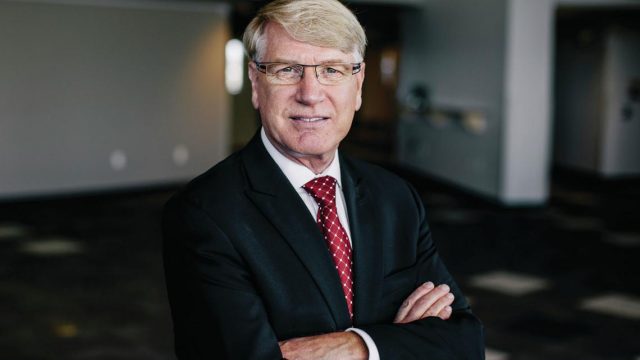Do We Measure the Success of a University President in Terms of Buildings Built?

Bismarck State College President Larry Skogen has announced that he’ll be retiring next year, which means the State Board of Higher Education will soon be paying consultants a silly amount of money to provide them with a slate of replacement candidates who will, in all likelihood, be mostly from other parts of the country.
Because these days the biggest decisions many our public officials make isn’t on policy so much as who to hire to make the decisions for them.
So it goes.
Anyway, Skogen’s tenure at BSC is profiled in the Bismarck Tribune today, but before we get there take a look at this graph showing recent trends for the school’s retention rate, graduation rate, and the number of diplomas earned (all data pulled from the fall iterations of BSC’s student profiles):
These are important metrics for the job performance of a university president, though certainly not all-encompassing. Based on these measures we can see that, at least during the latter part of Skogen’s tenure as president (he started in 2007), he’s had some modest success in improving outcomes for students.
That’s not a bad thing! But now let’s go to the Bismarck Tribune article to see how they portray Skogen’s time at BSC:
In 2008, he saw the completion of the National Energy Center of Excellence. In 2010, in partnership with Bismarck Public Schools, the Career Academy was built on the BSC campus.
This year, BSC officials, including Skogen, successfully petitioned the state Legislature for $8.9 million for a new health sciences building. The school also recently got approval from the State Board of Higher Education to become a polytechnic institution and offer four-year bachelor of applied science degrees in technical fields.
“Each year, we will continue to add four-year degree programs in technical fields that business and industry says they need,” he said.
It’s all about building buildings. That’s the summary of Skogen’s accomplishments at BSC, at least as portrayed by the Bismarck Tribune. There’s also some mention of Skogen’s time as interim chancellor for the North Dakota University System – he took over for a while after the tempestuous exit of former Chancellor Hamid Shirvani – and some of the work he had to do to adjust the school’s payroll in response to budget cuts.
Not mentioned anywhere in the article is how Skogen did in terms of serving the students. If we squint our eyes, maybe you could say the whole building buildings thing is about the students, but what good is building those buildings if outcomes for students don’t improve?
My intent here is not to pick on Skogen. As I mentioned, he seems to have presided over some modest improvements in student outcomes. That’s good! And, for what it’s worth, my oldest daughter is enrolled to attend Bismarck State College this fall.
My point is that when we talk about higher education we often talk about the wrong things. We use the wrong metrics for success. Too often when we talk about success in higher education it’s all about campus expansion or enrollment growth or sports championships, but those things are beside the point.
The most important metric for higher education achievement is student outcomes.
I wish we talked about that more.





